Here you’ll find a comprehensive guide and tips on how to freeze different kinds of food, so you can easily pack them for your bento box for a stress-free morning!
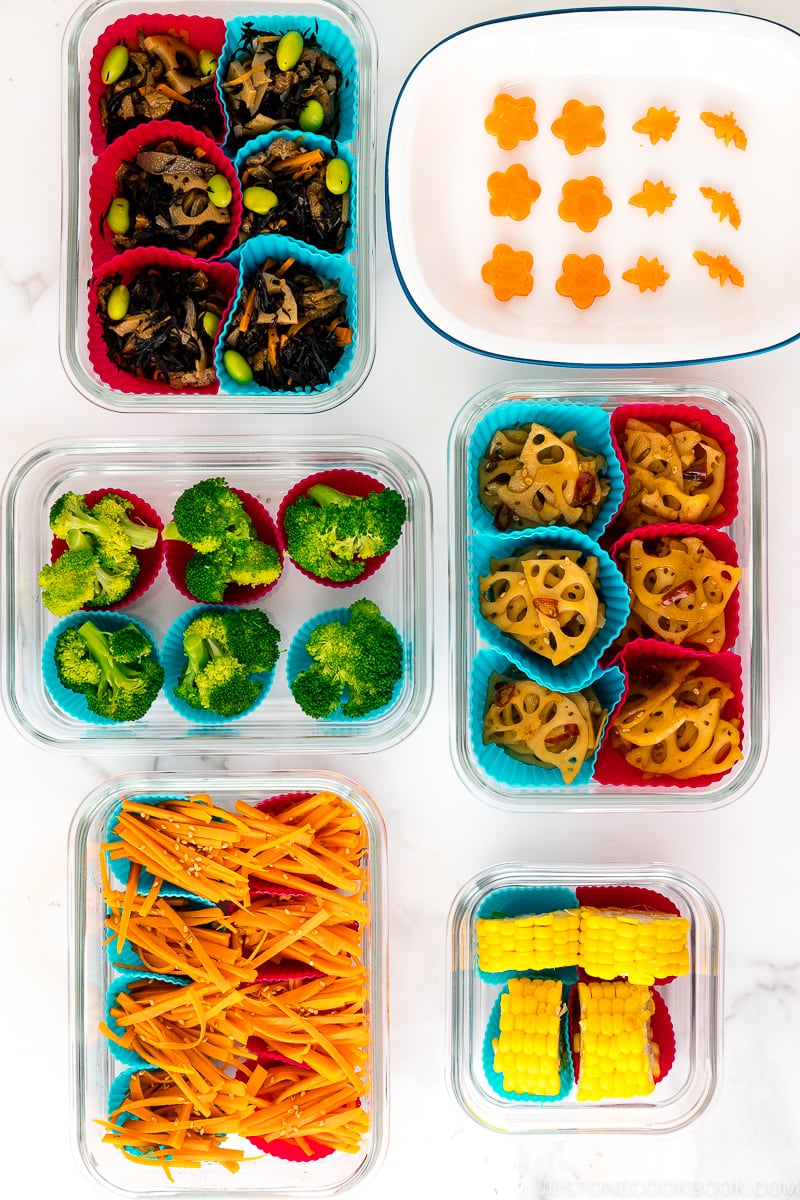
This is the basic guide to storing freezer-friendly dishes for your bento lunch box. Once you learn how to properly freeze pre-cooked meals, you can save so much time when making bento in the morning!
Table of Contents
Helpful Kitchen Tools
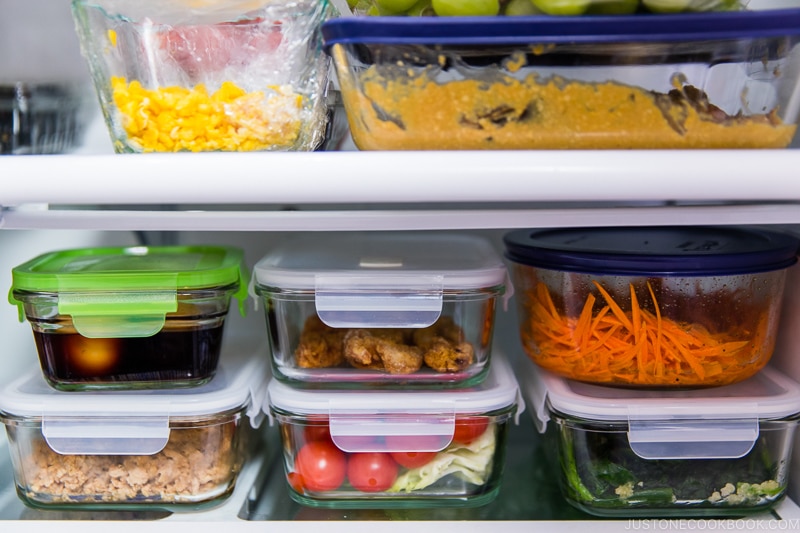
To keep everything organized, I find these containers and silicon cups extremely helpful.
- Glass containers for storing rice
- Glass containers for meal prep
- Silicone cups (I have both mini and regular sizes)
How To Freeze Cooked Rice
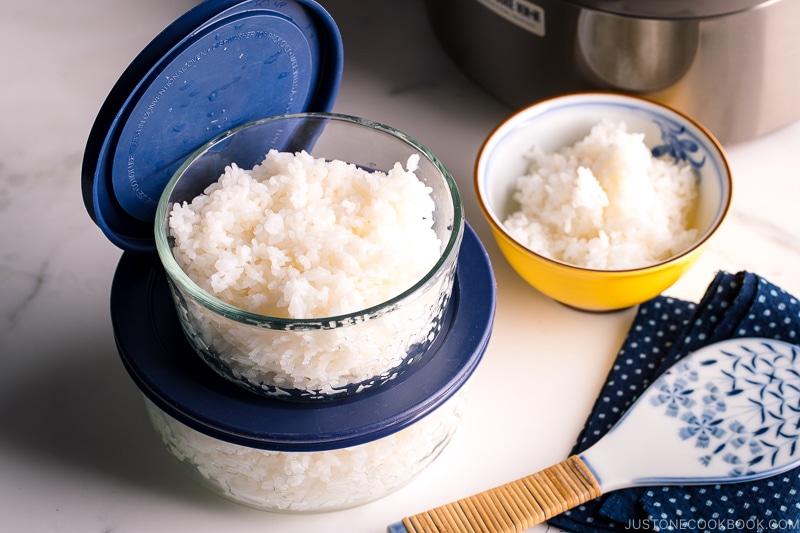
You don’t have to cook rice just to make bento every morning. My go-to method is to use frozen rice for bento, and I only make rice when I’m out of the frozen supply. Japanese people always keep their rice in the freezer, not in the fridge.
It’s so much easier to store extra steamed rice in the freezer and use it whenever needed. Even if we need rice for the following day, freezing it is the best way. Rice gets hard and dry in the fridge, but not if you store it in the freezer. I make extra and always keep a few containers of steamed rice in different portions in the freezer.
To make it easy, I have different-sized containers for a bento portion, 1 serving of rice, and 2 servings of rice. It’s easy to take it out and pop it in the microwave to defrost the frozen rice in the morning. Once the rice is warmed through, pack it in bento boxes or make rice balls (onigiri).
👉🏼 Read more about How to Store Cooked Rice or see the freezing instructions below.
How To Freeze Pan-Fried Food
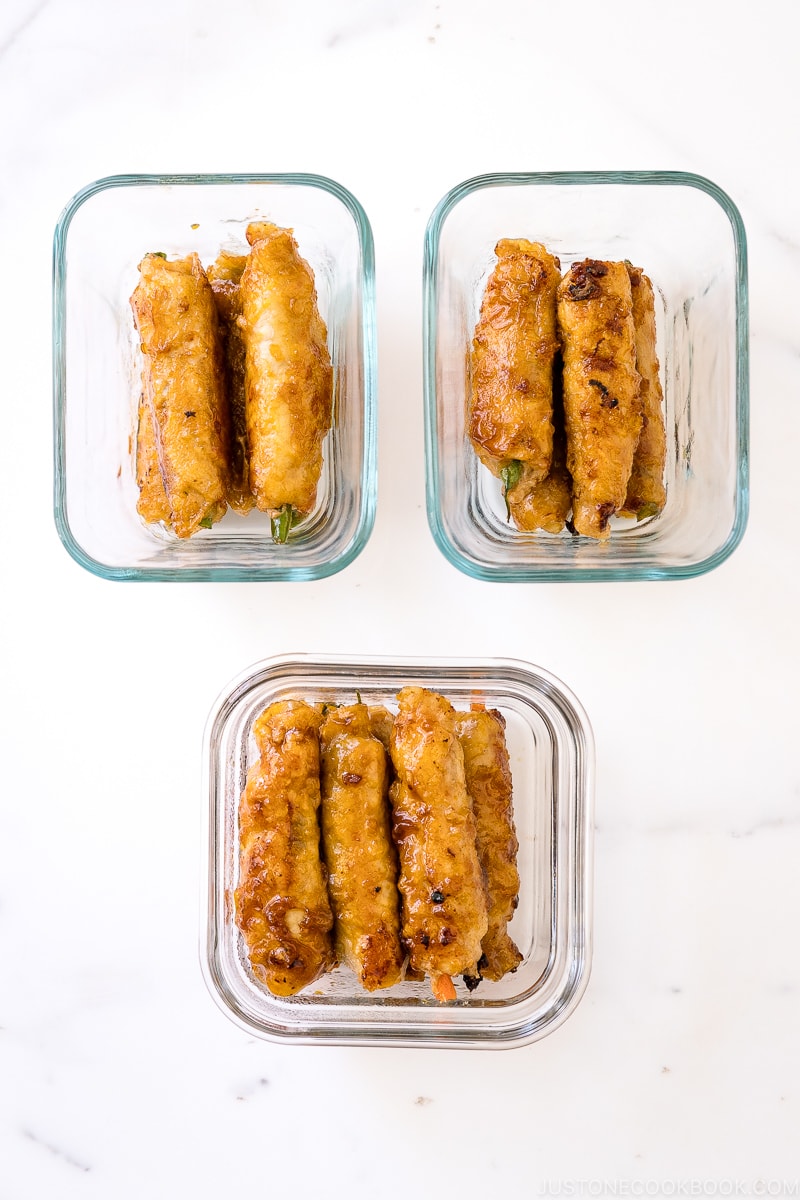
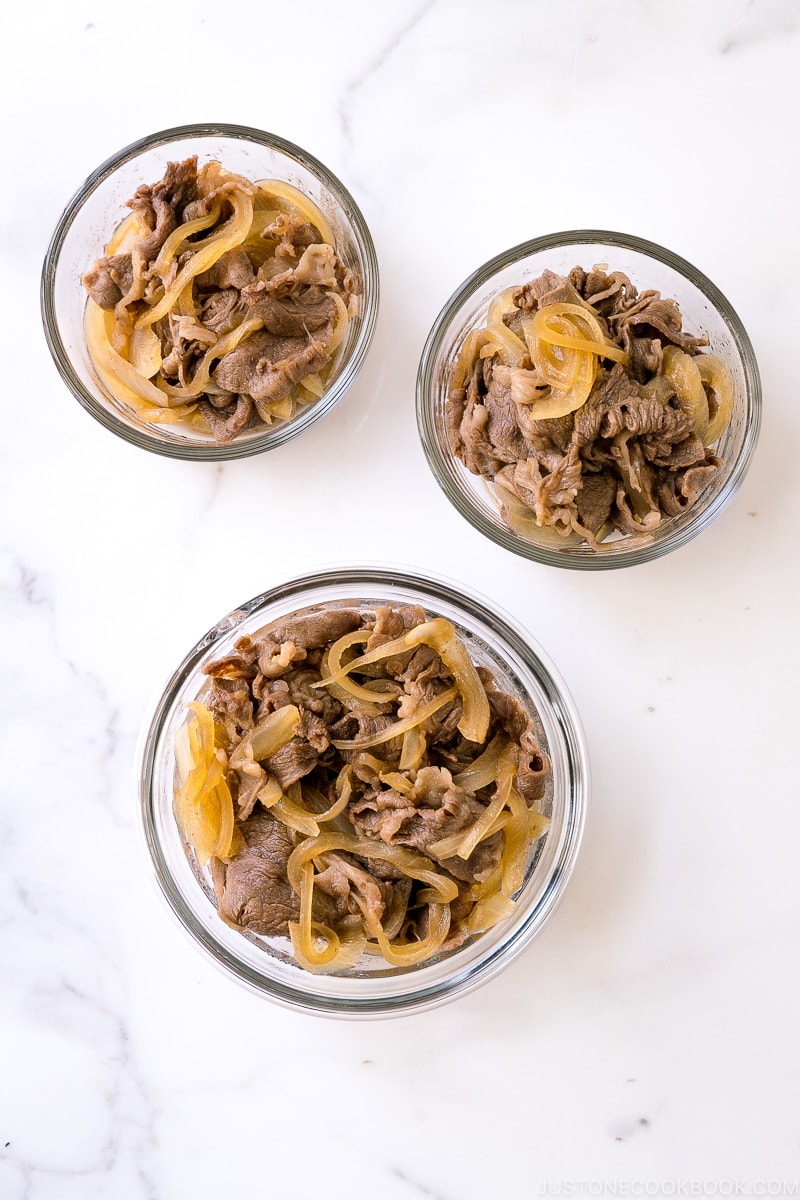
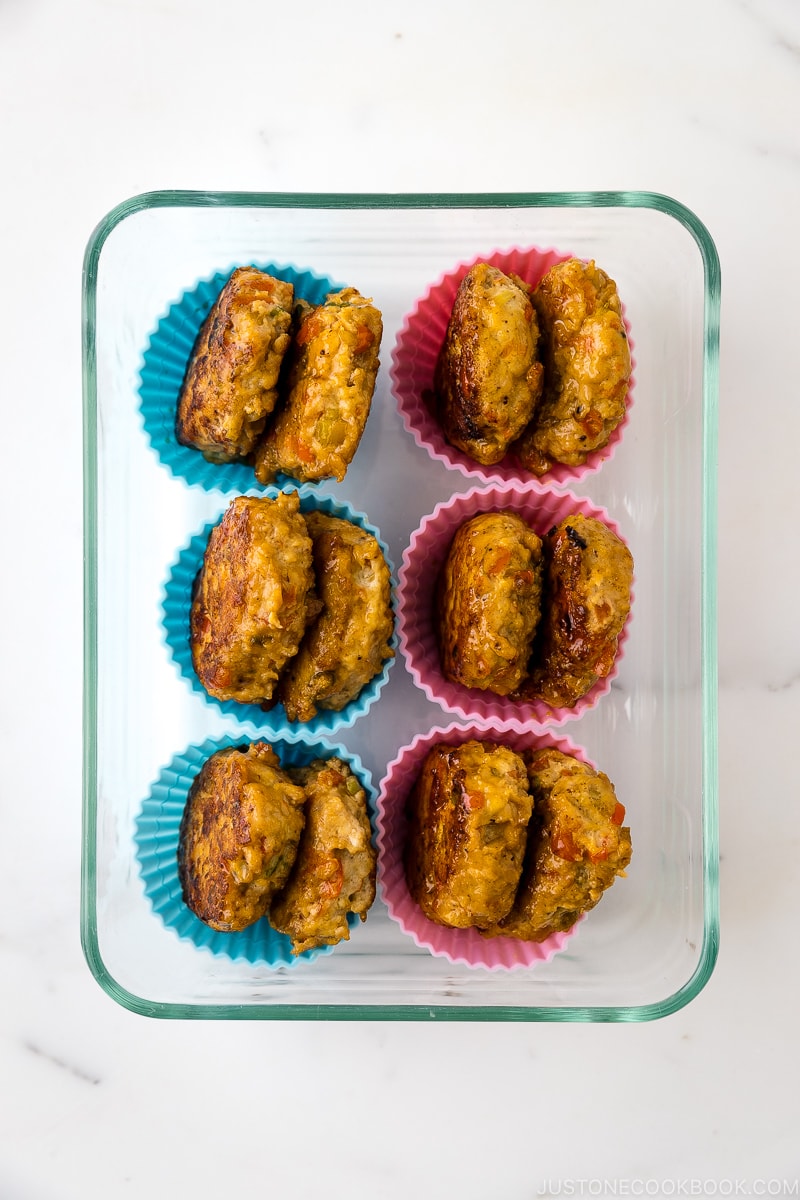
When packing for bento lunch boxes, I rarely make the main dish from scratch in the morning. Instead, I use leftover meals that I previously packed and saved in the freezer. It’s a similar concept to meal prep, but all dishes are kept in the freezer.
When you have leftover from dinner and don’t need to pack a bento for the next day, freeze the leftover dishes right away. I recommend packing in individual portions—1-2 servings in my case. This way, I can quickly defrost the exact portions I need for lunch boxes.
Depending on the type of pan-fried or simmered foods, utilize silicone cups so you can take out the exact portions you need.
Use airtight glass containers so you can microwave them. When reheating, remove the plastic cover and place a sheet of paper towel on top to avoid oil splatter and maintain the moisture in the food.
👉🏼 See the freezing instructions below.
How To Freeze Deep-Fried Food
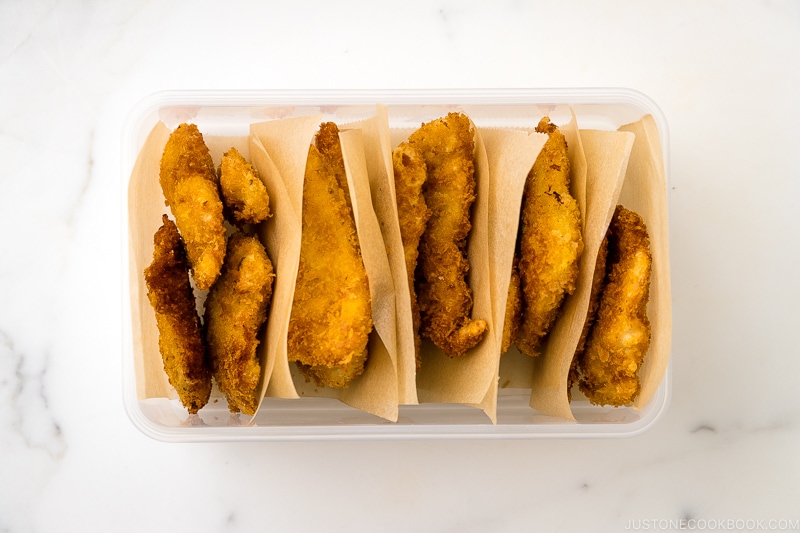
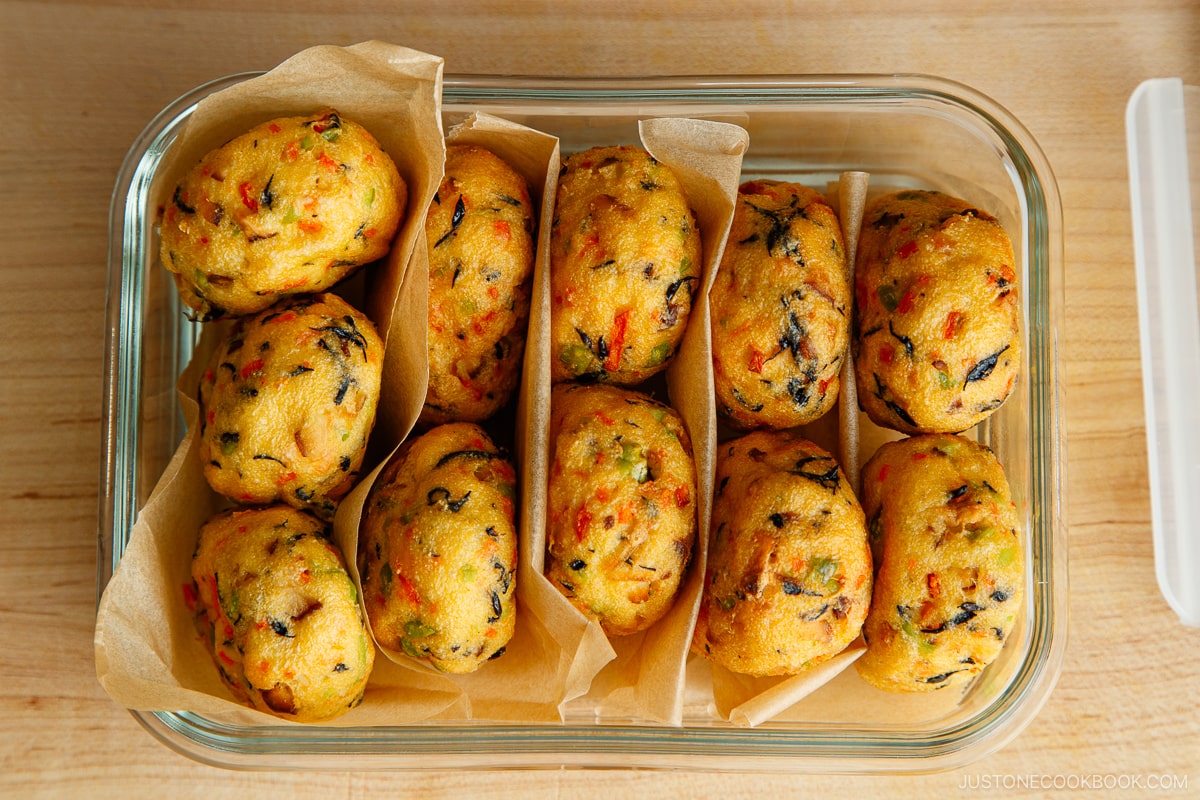
I always have leftovers whenever I deep fry food. It’s much easier to make a big batch and enjoy the fried foods another day without having to deep fry again.
If you are going to store all the fried foods in one container and will likely not use them all at once, use parchment paper to divide the pieces. This way, you can take out the pieces you need and reheat them. Without the parchment divider, the food will likely to get stuck together while freezing.
To reheat, I use a toaster oven or oven at 375°F (190°C) until warm. Don’t microwave, as the crust gets soft and lose the ‘deep-fried’ texture.
👉🏼 See the freezing instructions below.
How To Freeze Blanched Vegetables
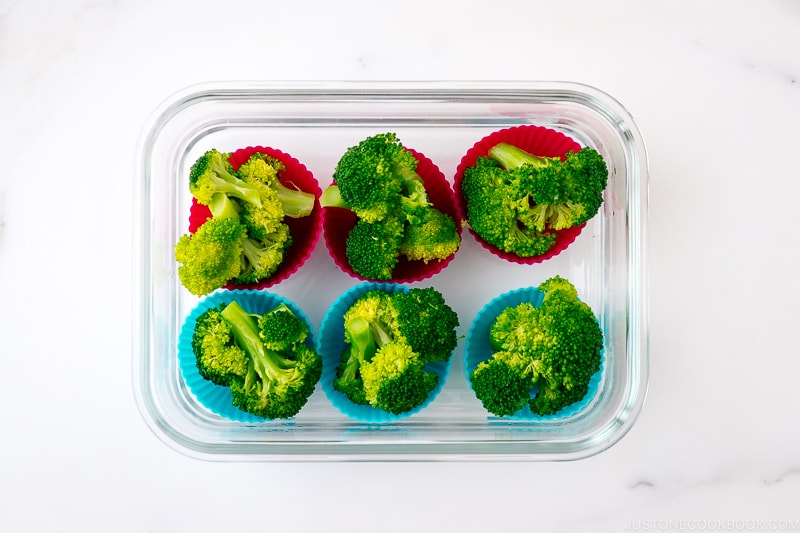
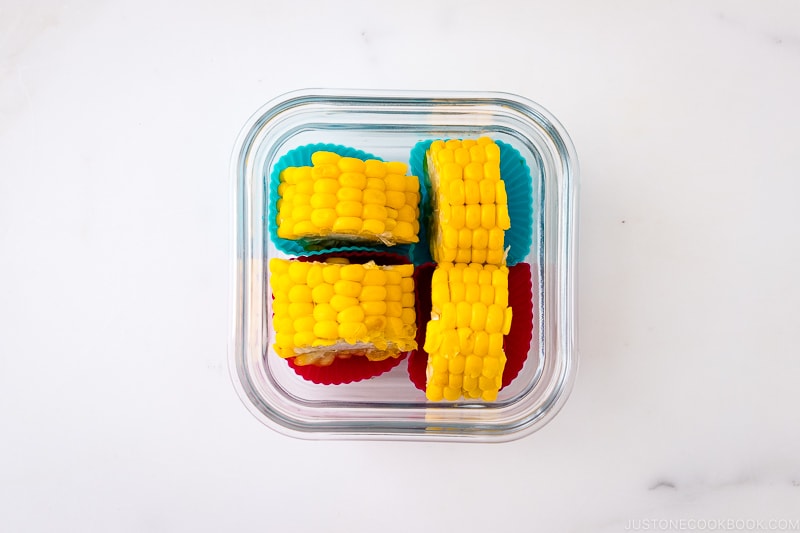
When packing bento, blanched vegetables come in handy for a few reasons.
- Vegetables add colors to the lunch box.
- You can cut down on additional cooking time (stir-frying, for example) if the vegetables are already pre-cooked.
- You can add the blanched vegetables directly into the lunch box with salad dressing or homemade sauce.
I always make sure I have a few kinds of blanched vegetables available in the freezer. It helps me prep bento lunches fast!
👉🏼 See the freezing instructions below.
How To Freeze Vegetable Dishes
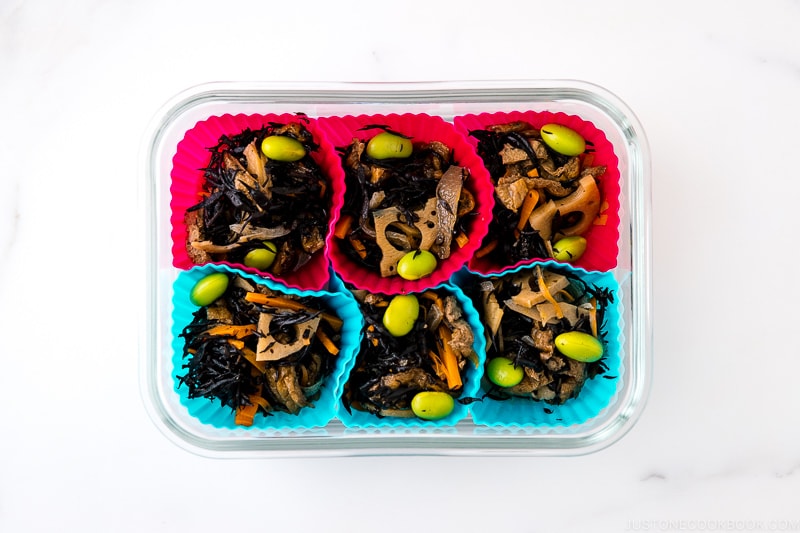
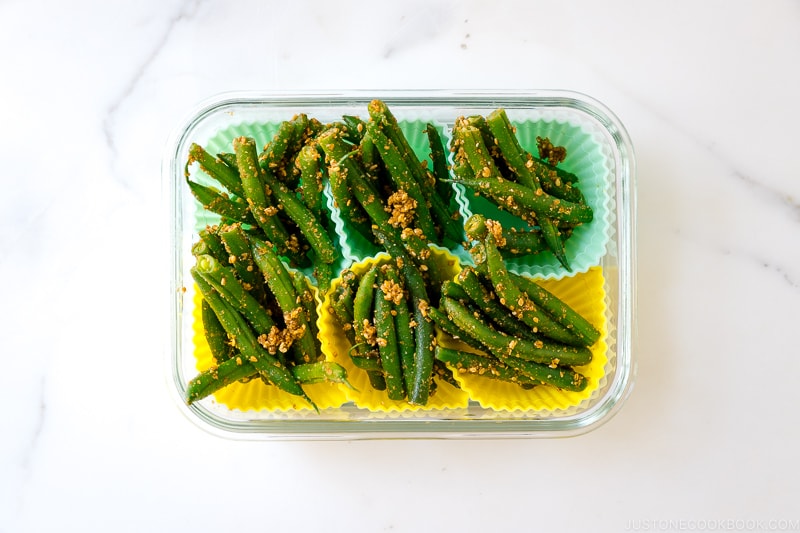
Make a big batch of vegetable side dishes and store them in the freezer. In Japanese cuisine, we have many dishes that are freezer-friendly.
- Hijiki Salad
- Green Bean Gomaae
- Spinach with Sesame Sauce
- Chrysanthemum Greens Salad
- Spinach with Sesame Miso Sauce
- Easy Carrot Salad (Carottes Rapees)
- Spinach Namul and Bean Sprout Namul
👉🏼 See the freezing instructions below.
How To Freeze Tamagoyaki
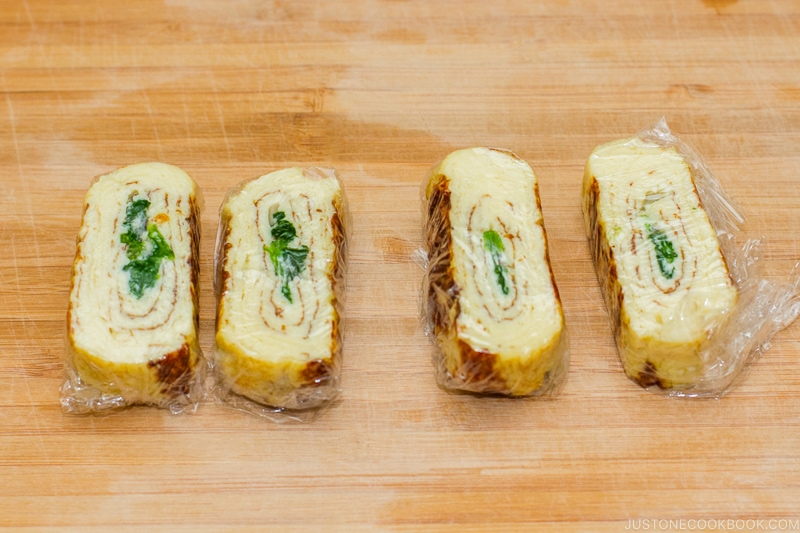
A bento classic, Tamagoyaki, can be frozen, too! I usually keep extra in the freezer so I can pack it in the bento box or enjoy it as a snack or part of breakfast.
👉🏼 See the freezing instructions below.
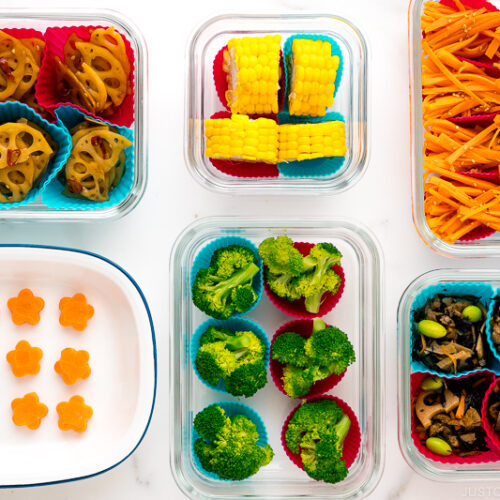
How To Freeze Food For Bento
Materials
- leftovers or meal prep food
Instructions
How To Freeze Cooked Rice
- (Ideally, as soon as the rice is done cooking) Pack the cooked rice with steam and cover the lid immediately to seal in the steam and moisture. Let cool completely on the kitchen counter. You do not want to spoil your food in the freezer with your hot/warm rice. Store in the freezer for up to 1 month. Reheat by microwaving.

How To Freeze Pan-Fried Food
- Put each portion of the cooked food in silicone cups or in separate small containers. Let cool completely, keeping the container lid(s) open, on the kitchen counter. Store in the freezer for up to 3 weeks. Reheat thoroughly by microwaving, pan-frying, or baking at 350ºF (180ºC).
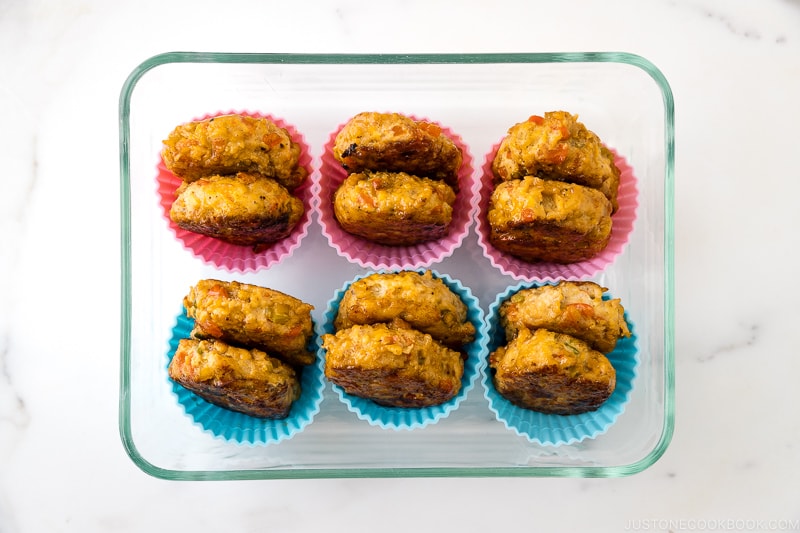
How To Freeze Deep-Fried Food
- After deep frying, let cool completely. Put them in a large airtight container, separating each portion with parchment paper. Store in the freezer for up to 3 weeks. Reheat thoroughly (without thawing) by baking at 375ºF (190ºC) in the oven or the toaster oven till heated through and crispy.

How To Freeze Blanched Vegetables
- Blanch vegetables (broccoli, asparagus, green beans, bell peppers, zucchini, carrots, corn etc) till tender but crisp (don’t overcook!). Drain well or squeeze water out. Let cool completely. Pat dry with a paper towel to make sure all the moisture is removed. Put each portion in silicone cups and put them in a larger container. Store in the freezer for up to 2-3 weeks. You can pack directly into your bento box (no reheating!) or thaw overnight in the fridge (and serve with a salad dressing), or cook/stir-fry in the morning while frozen.

How To Freeze Vegetable Dishes
- Drain, if there is any liquid, and put each portion in silicone cups and place them in a large container. Let cool completely. Store in the freezer for up to 2-3 weeks. Pack directly into your bento box (no reheating!) or thaw overnight in the fridge.

How To Freeze Tamagoyaki
- Let cool completely. Place the tamagoyaki slices in a container, keeping them separated so it’s easy to take one out. Or you can wrap each slice of tamagoyaki in plastic wrap and put it in a freezer bag. Keep in the freezer for up to 2 weeks. Pack directly into your bento box (no reheating!).

Wish to learn more about Japanese cooking? Sign up for our free newsletter to receive cooking tips & recipe updates! And stay in touch with me on Facebook, Pinterest, YouTube, and Instagram.
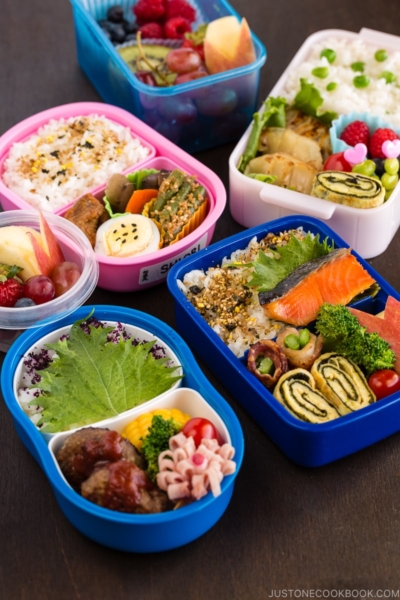
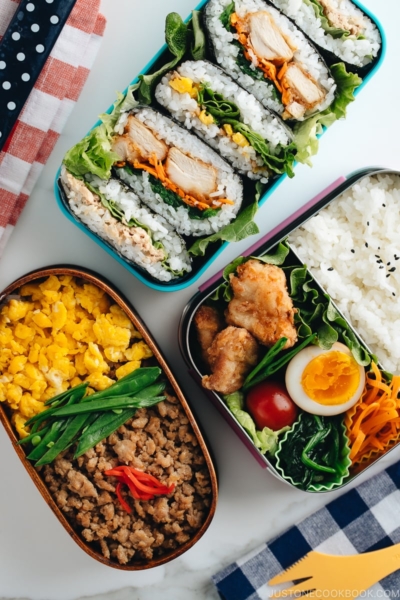
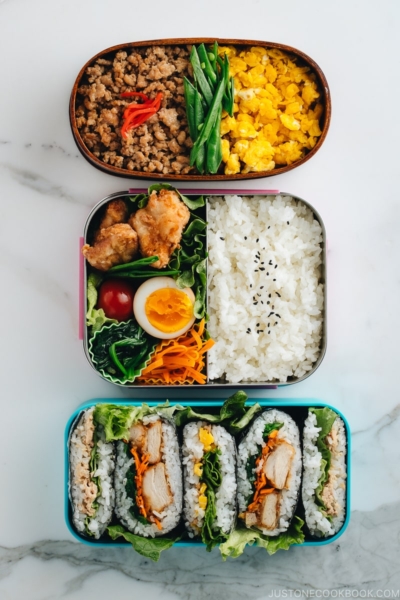
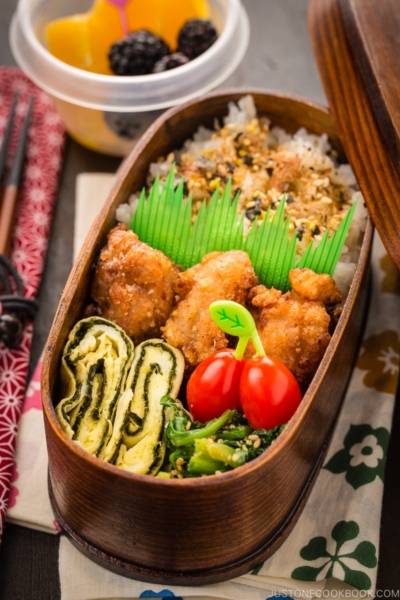




Hi Nami,
thank you so much for this detailed article. I am reading about how to make bento and this was great.
Hi Robin! Thank you so much for your kind feedback.
Nami and the rest of us at JOC are happy that you found this post useful.
Here’s a link to more Bento information. We hope you find it interesting.😊
https://www.justonecookbook.com/#search/q=bento
Hi Nami!
This is so helpful, thank you! I have a follow-up question about putting vegetables directly into the bento box without thawing/reheating, if I’m using a lunch jar (like the Zojirushi), will the vegetables completely thaw by lunchtime? I am not sure if the extra insulation might slow down the thawing process.
Thank you!
Meno
Hi Meno! Thank you very much for reading Nami’s post and for your kind feedback!
It depends on the type of your lunch box. If it’s an insulated thermos container, it might slow down the throwing process. If that is the case, recommend reheating the food in the morning and let it cool. Then you can pack it in the lunch jar.
We hope this helps!
In Australia we are told to either have rice hot (over 60degrees) then cool down very quickly and place in a fridge or freezer as soon as the steam is gone. If we reheat it we are told to reheat it very quickly and eat while hot, it’s recommended to only reheat once. We are taught that bacteria thrive between 0-60degrees Celsius, so based on that, it would make more sense to put cold rice in a bento box and to keep it cold with an ice pack, and eat it cold if not able to reheat at work. The only reason to reheat would be if you were going to keep it insulated and as hot as possible until eating. The idea of reheating and then letting it cool down under 60 degrees but not putting it in a fridge and eating again hours later sounds more dangerous than eating it cold and chilled with an ice pack all day. How does bringing the rice into the dangerous 0-60degree C zone make it safer, when it could be eaten cold (like sushi rice)?
Hi Tamara! Most Japanese do not keep the rice in the refrigerator and we freeze them to store. So we have to reheat the frozen rice in the morning. To bring the temperature of the hot rice to a safe cool temperature, using ice packs underneath is recommended and often used. Like you said lukewarm temperature is dangerous and you want to pass that as fast as possible. Once the rice is reheated, the texture becomes “fluffy” (I’m only talking about Japanese rice, not sure about other variety), and it will stay that way till lunch even though you put ice packs to keep it cool. However, the chilled rice (from the fridge) will never become fluffy if it’s kept chilled until lunchtime.
his is pretty standard method Japanese use for making the bento. This is not related but I don’t remember my bento was in an insulated lunch bag when I was a child, and it was wrapped in old fashion style bento box napkin. Thinking back, I’m surprised I (or kids back then) didn’t get food poisoning from not having an ice pack or insulated bag…
Thanks! That’s an awesome cultural insight!
It’s funny, but my husband is from a Chinese family and I think they didn’t have as much money when he was growing up straight after they immigrated, as a result I think he ate some low quality food (his sister even mentions unintentional bugs in the dried plant food delivered from overseas!) Now he can eat off the same plate as me and not get sick while I will! His mum would even leave rice in the rice cooker (off and on the counter) overnight and he wouldn’t get sick!
Hi Tamara! Some people have a strong stomach. I’m usually the weakest one so everyone in my family checks with me if I had any stomach before they worry. LOL.
Love your bentos!
Thank you Ellen! 🙂
HI Nami,
I know this is an old post but I have a few questions about freezing tamagoyaki. Every time I pack frozen tamagoyaki, a lot of juice comes out when thawing and leaks through my bento box. Any idea on how to solve this? Also, the texture becomes chewy and a little dry, instead of being soft and fluffy like fresh tamagoyaki. Is it something I’m doing wrong, or just a sacrifice we take for freezing it? Thank you so much!
Hi Annie! 1) When your tamagoyaki has lots of dashi (aka dashimaki tamago), the dashi is probably coming out as you defrost the tamagoyaki, especially when you put frozen tamagoyaki in the bento (no moisture escaping from reheating). 2) One way to solve is to put tamagoyaki in the silicone mold by itself, so juice sort of stay inside (unless you make bento upside down). 3) Dry and chewy… hmmm… nothing beats freshly made tamagoyaki. When you freeze the tamagoyaki, do you pack in airtight container and make sure it doesn’t get freezer burn? If so… probably due to freezing, texture may change… Hope this helps!